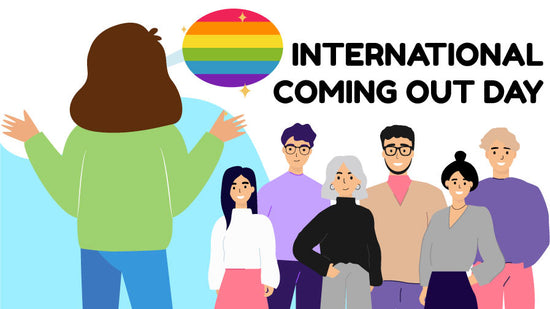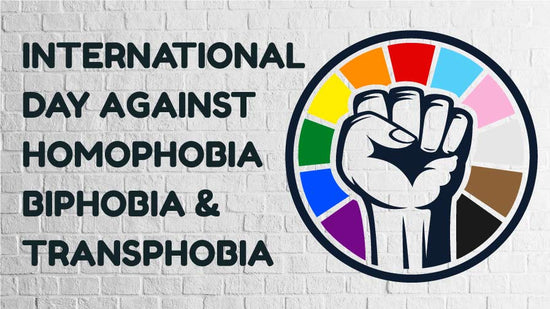World AIDS Day: What Is It And Why It's Still Important

When Is World AIDS Day?
World AIDS Day is on 1st December every year. This year it will fall on a Friday. It was conceived in 1987 by James W. Bunn and Thomas Netter, who worked on the Global Programme on AIDS at the World Health Organisation, and first observed in 1988.
What Is World AIDS Day?
Since the 1980s, AIDS has been one of the deadliest and most stigmatising illnesses in the world. It has taken millions of lives, many of whom were left to die alone in isolation. It has left countless millions of friends, families and loved ones helpless and grieving, and it has seen millions of people work tirelessly to find a way to those living with the disease.
It has also created huge social change, bringing the rights of gay men into the public eye in an unprecedented way. World AIDS Day was established at the height of the AIDS pandemic, to remember the lives lost, to highlight the long-term struggle for awareness and recognition, and focus attention onto the ongoing fight against the illness and the stigma around it.
World AIDS Day is one of the eleven official global public health campaigns marked by the World Health Organization (WHO).
People seem to think that AIDS is a disease of the 1980’s and ‘90s, but it’s still with us. It’s still infecting people and still killing people. And it’s critical that we don’t lose sight of this. So World AIDS Day is as important now as it ever was.
“World AIDS Day exists to shine a light on the real experiences of people living with HIV today, while celebrating the strength, resilience and diversity of the communities most affected.”
What Does The Red Ribbon Mean
In 1991 a much more visual emblem of the fight against AIDS appeared with the creation of the red ribbon. It was created by 12 artists of the Visual AIDS Artists Caucus, who wanted to launch a new project for Visual AIDS, a New York HIV-awareness arts organisation.
In the years since then has become widely recognised symbols on earth: the universal symbol of the fight against AIDS and a symbol for solidarity with HIV-positive people and those living with AIDS.
The artists vowed to remain anonymous. And wish merely to create a visual symbol to demonstrate compassion for those living with AIDS and their caregivers. The red colour was chosen for its, "connection to blood and the idea of passion—not only anger, but love, like a valentine."
The AIDS Memorial Quilt
Another hugely important representation of the communal effort to commemorate the loved ones we’ve lost is the AIDS Memorial Quilt, conceived by legendary gay activist Cleve Jones in 1985. There are now over 50,000 panels to the quilt, making it the largest community art project the world has ever seen.
Each panel features a name of someone who died of AIDS, alongside intimate messages and images from their loved ones. The total size of it laid flat would be 1.3 million square feet. The loving act of stitching these names into fabric represent the care that people gave to each other at the time. The panels physically taking up space in the world that the people they commemorate can no longer is incredibly moving.
My personal favourite piece of art that profoundly illustrates the effect of AIDS is Felix Gonzalez-Torres’ Untitled (Portrait of Ross in L.A.). The artwork is made of a pile of small, wrapped sweets in an ordinary gallery room. Visitors are invited to take a sweet, to eat it if they want. At the start, the pile weighs 175 pounds, which was how much Gonzalez-Torres’ boyfriend Ross weighed when he was diagnosed with AIDS. Every sweet that is taken from the pile represents the illness taking away Ross’ body weight and then his life.

It was first exhibited in 1991, and Ross died shortly after. When all the sweets have gone, they are immediately replaced, showing the ongoing nature of AIDS, and the grief we feel for those we lost too soon.
World AIDS Day is a time to learn more about these artworks, these projects, the people we lost and the people who fought to save lives. This fight will continue until everyone is treated with the respect and care they deserve.
The Early Fight Against HIV/AIDS
From the beginning of the 1980s AIDS ravaged queer communities around the world, particularly in major cities like London and New York. But one of the first places that the disease took hold was San Francisco, where a vibrant gay community had been growing since the 1960s.
Cleve Jones said of San Francisco: “We saw people die all around us. On one block in my neighbourhood, everybody died in the span of two years. Ultimately over 20,000 gay men would die in this neighbourhood.”
People from every part of the LGBTQ+ community came together to lovingly support each other, making DIY medicines when healthcare systems failed them, and protesting against the governments that were turning a blind eye to their suffering. In the US, the lesbian community turned out to nurse their gay friends in the hospitals, because most of the heterosexual nurses refused to do it. As a result, many lesbian nurses died of the disease.
President Ronald Reagan blamed the “morality” and “ethical behaviour” of gay men at the time, suggesting “abstinence” would solve the problem. His administration’s first response to hearing about the epidemic was to laugh. Reagan eventually invested a budget into fighting AIDS, but it was too little, too late.
Most of the fight came from the ground up, grassroots initiatives of volunteers such as ACT UP who gave their time and energy to caring for their friends and loved ones. There was a great unity in the LGBTQ+ community, with lesbians looking after gay men and transgender people taking prominent roles in protests and activism.
With institutional homophobia still rife within law enforcement in both the UK and US, most gay men didn’t trust the police. Manchester chief of police James Anderton even described gay men at the time as “swirling around in a cesspit of their own making.” And the media were culpable in spreading the fear and homophobic propaganda that was being fed to them.
There were few allies at the time, most notably Madonna, who included advice pamphlets for safe sex with her albums, and Princess Diana, who helped shift public opinion when she shook the hand of a man with AIDS, calling for respect and love towards everyone affected.
Why Is The Fight Against AIDS Still Important?
There is still a huge stigma against people living with HIV. This can affect all areas of their life, from work to education to housing to healthcare to dating.
Many people still have negative perceptions of those living with HIV. Or still believe the outdated misconceptions about how it can be passed on, or that it’s a disease only for gay men. This last issue is one of the reasons why AIDS has become so prevalent in many third world countries, where poor education around the disease and religious intolerance of LGBTQ+ people has meant that many who are infected refuse to be tested because of the social stigma attached to an HIV diagnosis.
Thanks to modern medicine, those who live with HIV can live a long and healthy lives. Many people take medication such as PrEP (Pre-Exposure Prophylaxis) which is highly effective in reducing the transmission rates of HIV.
World AIDS Day exists to “shine a light on the real experiences of people living with HIV today, while celebrating the strength, resilience and diversity of the communities most affected. It is a moment to inspire the leadership needed to create a future where HIV doesn’t stand in the way of anyone’s life.”
Many people think AIDS is a historical issue, that it went away after the 1980s. But it’s still a problem today, as much through people’s attitudes towards it as the illness itself. Our anger at the injustice will never fade away. Our grief for the brilliant people we lost will never leave us. Our passion to keep fighting for the health and happiness of al LGBT+ people will push us further than we ever thought possible.
The AIDS crisis may have shown the apathy of governments and heteronormative society towards the struggles of the queer community, but it also showed our potential to come together, to care for each other, and to make our voices heard. By commemorating World AIDS Day every year, we will never forget this.
The Numbers Behind The AIDS Pandemic
More than 40 million people have died of HIV or AIDS related illnesses over the past 40 years, making it one of the most destructive pandemics in history.
Currently in the UK, more than 105,000 people are living with HIV.
Globally, an estimated 39 million people were living with the virus in 2022.
Contrary to popular belief, 53% of those people are women and girls.
1.3 million people were newly infected with HIV last year.
Almost 30 million people accessed antiretroviral therapy.
The good news is that AIDS related deaths have reduced by 51% since 2010.
What You Can Do To Support World AIDS Day
The definition of Transgender is someone who identifies as a gender different to the one they were assigned at birth. But many Intersex people identify and live happily as their assigned gender.
There are, however, some Intersex people who identify as a different gender (either the opposite binary or Non-Binary) and these people may also identify as Trans.
So while there is an overlap, the two identities are separate. The important thing is to respect an individual person’s identity, and appreciate the nuances between them.
The main difference is that Intersex people are born with a combination of “typically” male and female sex characteristics, whereas non-Intersex Trans people aren’t.
What Is AIDS and HIV
Human Immunodeficiency Virus (HIV) is an infection that attacks the body’s immune system, weakening your ability to fight everyday illnesses. It can lead to Acquired Immune Deficiency Syndrome (AIDS) when your immune system is so damaged that infections become life-threatening. Symptoms include fever, joint pain and lesions across the body.
HIV is contracted through the sharing of certain bodily fluids such as semen, vaginal and anal fluids, blood and breast milk. The most common way of getting HIV is through having anal or vaginal sex without a condom. It can also be passed through sharing needles.
According to Matthew Hodson, executive Director of NAMS aidsmap, it cannot be passed through: Spitting, mosquitos, kissing, tea cups, toilet seats, towels etc. It is also extremely unlikely that it can be passed via a discarded needle because these very rarely contact fresh blood.
Resources To Find Out More
FREE TESTING
Free HIV and syphilis test kits are available to people from certain areas in England. Depending on your eligibility there are 2 options for HIV testing.
During National HIV Testing Week (usually in February) and other periods of national promotion, the Department of Health and Social Care funds Freetesting.hiv to offer HIV and syphilis tests for people 16+ throughout England.
NATIONAL AIDS TRUST
National AIDS Trust is the UK’s HIV rights charity. It works to stop HIV from standing in the way of health, dignity and equality, and to end new HIV transmissions.
TERRENCE HIGGINS TRUST
Terrence Higgins Trust is a British charity that campaigns on various issues related to AIDS and HIV. You can also use their free HIV test finder tool.
I-BASE
HIV i-Base is an activist group, providing HIV treatment information to HIV-positive people.
NATIONAL AIDS MEMORIAL










